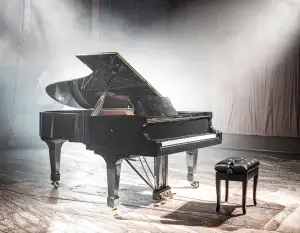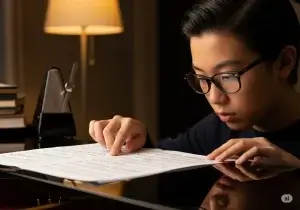If you’re just starting to play piano, choosing the right instrument can feel overwhelming. As a beginner pianist in Mississauga, Ontario, you might wonder whether you need an acoustic piano, a digital piano, or a simple keyboard. In this guide (written on behalf of Silver Maple Piano Studio), we’ll cut through the confusion with straight-to-the-point advice. Each section below answers a common beginner question, so you can find the best piano for beginners and start your musical journey on the right note.
Acoustic vs Digital: Which is Better for a Beginner?
Acoustic pianos vs digital pianos is a common dilemma for new players. An acoustic piano (upright or grand) offers authentic sound and touch, which is ideal for developing proper technique. In fact, most teachers agree the ideal instrument for learning is an acoustic piano because of its rich dynamic range and expressiveness. However, acoustics are expensive, large, and require maintenance like regular tuning and proper humidity control (ideally ~45 – 70% relative humidity at ~20°C). They also can’t be used with headphones for silent practice, which can be an issue in apartments or shared homes.
Digital pianos, on the other hand, have come a long way. A good digital piano mimics the feel and sound of an acoustic while being more affordable and compact. You can adjust volume or use headphones, making them apartment-friendly. Digital instruments also never need tuning and often include useful features like metronomes or recording functions. For these reasons, digital pianos are often recommended for beginners and parents who want to test a child’s interest without a huge investment. In fact, many entry-level digitals include multiple instrument sounds and connectivity (USB/MIDI) that can make practice more fun.
What about simple electronic keyboards?
Portable keyboards (usually 61 or 76 keys) are inexpensive; however, most have unweighted keys and limited range, which means they don’t feel like a real piano and will hinder development of proper technique. Most teachers advise beginning to learn on a full-size instrument. Some experts even argue that starting on a smaller keyboard can slow progress during the transition to a real piano, and that young learners should “”jump straight in on a full sized instrument”” if possible.
If you can afford it and have space, an acoustic piano is best in the long run. But for most beginners, a digital piano with weighted keys is the perfect starting point. It offers a realistic playing experience and convenience at a fraction of the cost of an acoustic. Keyboards (with fewer keys or no weighted action) should be avoided.
Essential Features to Look For in a Beginner Piano
No matter which type of piano you choose, there are certain key features you should look for as a beginner. These will ensure the instrument supports your learning instead of holding you back:
Full 88 Keys (Standard Size)
A full-size keyboard (88 keys) is recommended so that you learn on the same range you’ll use on any piano. Full-sized keys (both in number and physical key size) help develop proper hand spacing and finger technique from day one.
Weighted, Touch-Responsive Action
Weighted keys mimic the resistance of an acoustic piano’s keys, helping you get accustomed to the key “resistance” of a real piano and teaching you dynamic control (playing soft or loud). Touch-responsive (velocity-sensitive) means the harder you press, the louder the sound – a must for expressive playing. Avoid cheap unweighted keyboards; a good weighted action reinforces proper technique and prevents bad habits, while a flimsy, springy keybed can be uninspiring and detrimental. In short, the better the keys feel, the better you’ll play in the long run.
Good Sound Quality
Sound is a huge part of enjoyment. If you love the piano’s tone, you’ll be more motivated to practice. Higher-quality digital pianos use advanced sound engines or sampling technology to produce rich, realistic piano tones. Cheaper ones might have thin or artificial-sounding tones that aren’t satisfying. Listen and compare models if you can – trust your ears and choose a piano sound you find pleasing. (For acoustic pianos, sound quality comes down to the piano’s design and condition; even a smaller upright should have a pleasant tone and remain in tune.)
Sturdy Build and Reliability
A piano is an investment, so look for an instrument that will last until you’re ready to upgrade. Extremely cheap off-brand digital pianos or keyboards might save money upfront but often “feel uninspiring to play and frequently go wrong”, meaning you could face malfunctions. It’s better to spend a little more on a reputable brand that will provide a solid experience for years. If buying a new acoustic piano, be aware that anything significantly cheaper than standard market prices may have quality or preparation issues – one piano retailer notes that new upright pianos below a certain price often haven’t had proper tuning and regulation before sale.
Practice-Friendly Features
Consider features that can support your learning. Headphone jacks are extremely useful on digitals so you can practice without disturbing others (or being disturbed). Built-in metronomes help you keep time, and recording functions let you evaluate your playing. Many modern digital pianos also connect to apps or online lessons via USB or Bluetooth, which can make learning more engaging. These extras aren’t absolutely necessary, but they can be nice bonuses. Just be careful not to get distracted by too many buttons and gadget features – the goal is to practice piano, not to play with settings all day. Simplicity can be a benefit for focus.
Budget Considerations: How Much Should You Spend?
Beginner pianos come in a wide range of prices. It’s wise to set a budget, but remember that with musical instruments, you often get what you pay for in terms of quality. Here are some budget tips for beginners:
Digital Pianos
You can find basic new digital pianos in the $500 – $800 range (CAD) that meet the essential criteria (88 weighted keys, decent sound). In fact, one reputable piano seller suggests budgeting at least $800 if you want a digital piano that fulfills all the fundamental requirements for learning. Spending a bit more (around $1,000 – $1,500) can get you a mid-range digital with improved sound and feel – for example, popular home models like the Yamaha Clavinova series start around $2,000 for their entry-level console pianos. Beware of ultra-cheap digital keyboards under a few hundred dollars; as mentioned, they tend to cut corners on key action and sound. An instrument that is too cheap might end up discouraging a student. It’s often a false economy if a bargain keyboard makes practice unenjoyable or needs replacement quickly.
Acoustic Pianos
Acoustic uprights are more expensive. Brand-new student upright pianos typically start around $5,000 – $7,000 (for reputable brands). For instance, a dealer might list entry-level uprights around the $6,500 mark, because below that price the pianos likely lack proper factory preparation and will not perform or last as they should. If that’s out of budget, consider a used piano – high-quality used uprights (Yamaha, Kawai, etc.) can often be found for a few thousand dollars. Just have a technician inspect a used piano before buying, to avoid inheriting problems. Another option is renting an acoustic piano, which some music stores in Mississauga offer for a monthly fee. This can be a smart interim solution if you’re not ready to commit to a purchase but want an acoustic for practice.
Renting Your Piano
If your budget is very tight or you’re unsure about long-term commitment, renting a digital piano is an option. You can then purchase a piano of your choosing (digital or acoustic) if the student sticks with it.
Value vs Price
Always evaluate the value you’re getting, not just the price tag. A slightly more expensive model that sounds and feels great is worth it because you’ll enjoy playing it and won’t outgrow it too quickly. Conversely, a rock-bottom cheap instrument that frustrates you is not a good deal, even if it saves money upfront. Think of your first piano as an investment in your education. It should be something that invites you to sit down and practice every day.
Recommended Pianos and Brands for Beginners
To help you navigate the options, here are a few beginner-friendly pianos that are widely praised. These examples span digital and acoustic categories:
Entry-Level Digital Pianos
Look for models with 88 weighted keys from well-known brands like Yamaha, Casio, Roland, or Kawai. For instance, Yamaha’s P-series (like the Yamaha P-45 or P-125) and Casio’s CDP or PX Privia series are popular for beginners. They offer authentic piano feel and sound at a reasonable cost. (A retailer-recommended choice is the Casio CDP-S160 or Yamaha P-143, which have fully weighted 88-key action and are ideal for learning.) Roland also has the FP-10 and FP-30X models which are excellent in touch and tone for their price. These digital pianos are portable and can be used with optional stands and three-pedal units to mimic an upright piano setup.
Console Digital Pianos
If you prefer a furniture-style digital piano that looks more like an upright, consider the Yamaha Arius (YDP) series or Roland RP/Upright series. These come with a cabinet and built-in pedals. For example, the Yamaha YDP-145 or Roland RP-102 are examples of entry-level console digitals that beginners and families often choose for the living room. They provide a more traditional aesthetic while still being lower maintenance than acoustics.
Acoustic Upright Pianos
For those ready to invest more, acoustic uprights from Yamaha or Kawai are a solid choice. Models such as the Yamaha U1 (a famous studio upright) are considered gold-standard for students – in fact, it’s the world’s best-selling upright piano. New Yamaha/Kawai uprights are pricey, but you can often find used ones in good condition. Other reputable beginner upright brands include Essex or Boston (designed by Steinway) for mid-range budgets. Remember, if you get an acoustic piano, factor in the cost of tuning (usually 1-2 times a year) and maintaining a stable environment (avoid extreme humidity swings) to protect your instrument.
A young student practices on a digital piano with headphones. (Digital pianos allow silent practice with headphones and usually take up less space than traditional uprights, a big advantage for beginners practicing at home.)
Final Thoughts
Choosing the best piano for a beginner comes down to finding an instrument that feels good to play and inspires you to practice. For many beginners in Mississauga and elsewhere, a quality digital piano hits the sweet spot in balancing realism, convenience, and cost. It’s generally not recommended to start on a very cheap, unweighted keyboard if you can avoid it – that might lead to frustration or technique issues. Instead, aim for the most piano-like experience your budget allows, whether that’s a solid digital piano or a well-maintained acoustic upright.
If you’re still unsure, don’t hesitate to seek expert advice. At Silver Maple Piano Studio, we have helped many new students select their first piano. We understand every beginner’s situation is unique. Consider visiting local music stores in the Greater Toronto Area to try out different models; feeling the key action and hearing the sound in person can make the decision clearer. Remember, the best piano for you is one that suits your needs, fits your space and budget, and motivates you to play every day. With the right instrument, you’ll be well on your way to enjoying music and making steady progress on the piano. Good luck and happy playing!







